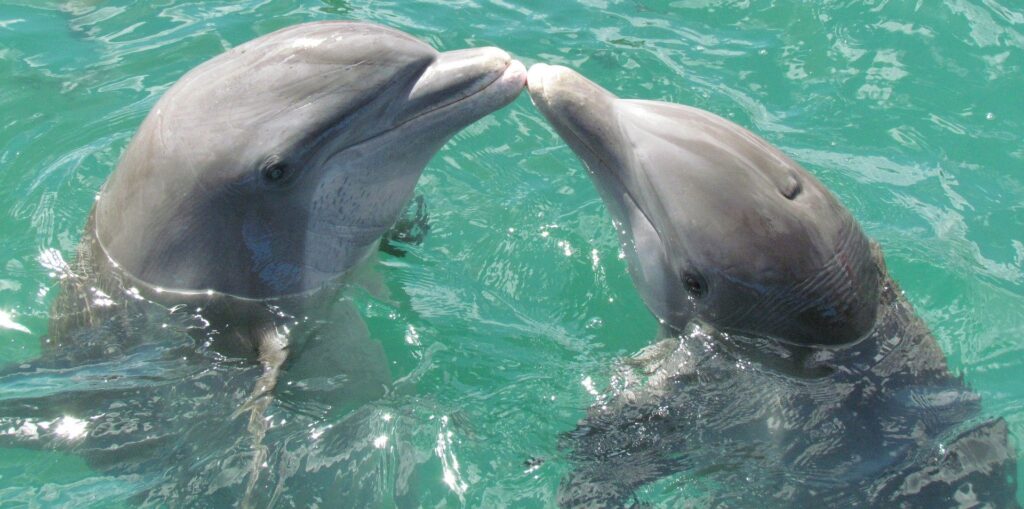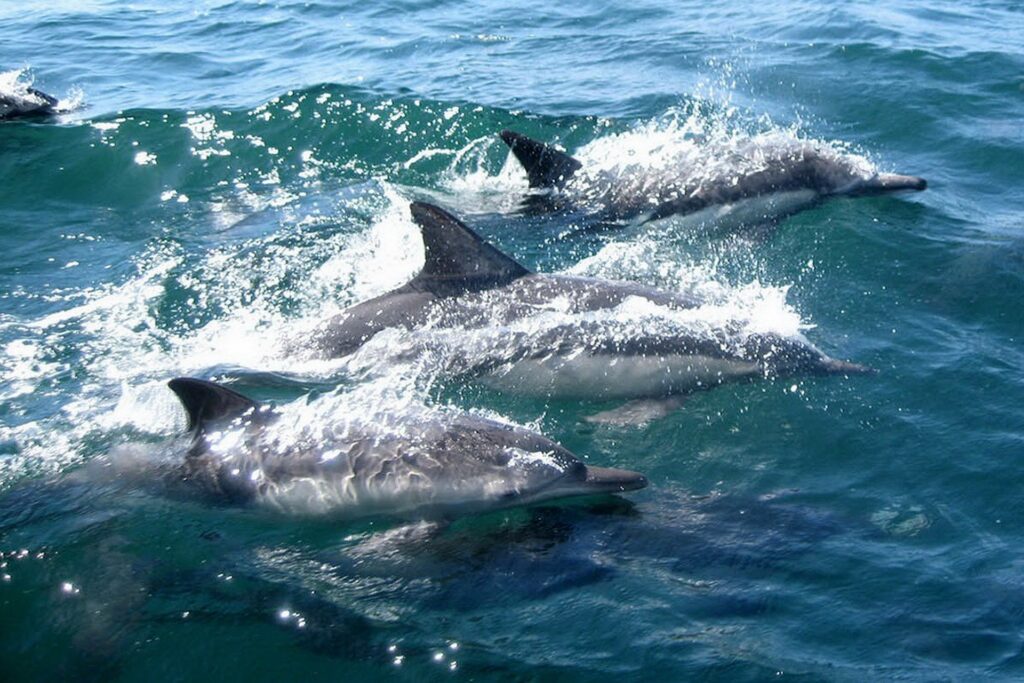Dolphins are highly intelligent and social marine mammals that are adored by many. They are known for their playful nature, acrobatic skills, and their unique ability to communicate with each other through a variety of sounds. In this article, we will explore what exactly dolphins are, their origin and evolution, their habitat, the different types of dolphins, their characteristics, and what they feed on.
What Exactly are Dolphins?
Dolphins are aquatic mammals that belong to the family Delphinidae. They are highly intelligent and social creatures that are known for their playful behavior. They have streamlined bodies, which make them highly adapted to life in the water. Their bodies are covered in smooth skin, which is typically gray in color. Dolphins are warm-blooded animals, which means that they can regulate their body temperature.
Origin and Evolution of Dolphins

Dolphins evolved from land mammals over 50 million years ago. Their ancestors were terrestrial animals that lived near the water. Over time, these animals evolved to become better adapted to life in the water. Their limbs evolved into flippers, their bodies became more streamlined, and they developed a blowhole on the top of their heads, which allows them to breathe air while swimming.
Habitat of Dolphins
Dolphins can be found in oceans and seas all over the world. They prefer warm, tropical waters, but can also be found in colder waters, such as the North Atlantic. Dolphins are highly adaptable creatures and can live in a variety of different habitats, including coastal areas, estuaries, and open ocean.
Types of Dolphins

There are over 40 different species of dolphins, each with their own unique characteristics. Some of the most common types of dolphins include the bottlenose dolphin, the common dolphin, the spinner dolphin, the dusky dolphin, and the spotted dolphin.
let’s delve deeper into the different types of dolphins:
- Bottlenose Dolphin – This is one of the most well-known and recognizable species of dolphin. They are found in oceans and seas all over the world, and can also be found in many aquariums and marine parks. They are known for their intelligence, playfulness, and social nature. Bottlenose dolphins can grow up to 13 feet in length and weigh up to 1,400 pounds.
- Common Dolphin – The common dolphin is found in warm and temperate waters around the world. They have a distinctive hourglass pattern on their sides and are highly social animals that live in large groups. Common dolphins can grow up to 8 feet in length and weigh up to 350 pounds.
- Spinner Dolphin – This species of dolphin is known for its acrobatic displays, which include spinning and leaping out of the water. They are found in warm, tropical waters around the world, and are highly social animals that live in large groups. Spinner dolphins can grow up to 7 feet in length
- Dusky Dolphin – The dusky dolphin is found in the coastal waters of South America and New Zealand. They are highly acrobatic animals that are known for their aerial displays. Dusky dolphins have a distinctive black and white pattern on their sides and can grow up to 7 feet in length and weigh up to 200 pounds.
- Spotted Dolphin – The spotted dolphin is found in warm, tropical waters around the world. They have a distinctive spotted pattern on their sides and are highly social animals that live in large groups. Spotted dolphins can grow up to 7 feet in length and weigh up to 250 pounds.
- Hector’s Dolphin – This species of dolphin is found only in the coastal waters of New Zealand. They are one of the smallest species of dolphin, growing up to only 4.5 feet in length and weighing up to 110 pounds. Hector’s dolphins are also one of the rarest species of dolphin, with only around 7,000 individuals remaining in the wild.
- Risso’s Dolphin – Risso’s dolphins are found in temperate and tropical waters around the world. They have a distinctive scarred appearance due to the markings left by other dolphins during social interactions. Risso’s dolphins can grow up to 13 feet in length and weigh up to 1,100 pounds.
These are just a few examples of the many different species of dolphins that exist in the world. Each species has its own unique characteristics and behaviors, making them all fascinating animals to learn about and observe.
Characteristics of Dolphins

Dolphins are known for their intelligence, social nature, and acrobatic displays. They are also highly adaptable animals that are capable of living in a variety of environments. Some other interesting characteristics of dolphins include:
- Intelligence: Dolphins are widely regarded as one of the most intelligent animals on the planet. They have large, complex brains that are capable of problem-solving, decision-making, and even self-awareness. Studies have shown that dolphins are able to recognize themselves in mirrors, a sign of advanced cognitive abilities.
- Social Behavior: Dolphins are highly social animals that live in groups, called pods, that can number in the hundreds. These pods are typically made up of family members and can exhibit complex social dynamics, including cooperative hunting, play behavior, and communication.
- Communication: Dolphins are known for their complex system of communication, which includes a variety of vocalizations, body language, and even touch. They use these methods to communicate with each other, coordinate hunting efforts, and establish social hierarchies within their pods.
- Echolocation: Dolphins use echolocation to navigate and locate prey in their environment. They emit high-frequency clicks and listen for the echoes that bounce back to them, which allows them to build a detailed mental map of their surroundings. This ability is so finely tuned that dolphins are even able to distinguish between different types of fish by their echoes alone.
- Physical Adaptations: Dolphins have a number of physical adaptations that make them well-suited to life in the water. They are streamlined and agile swimmers, with powerful tails that allow them to reach speeds of up to 20 miles per hour. They also have a layer of blubber to help them stay warm in cold water, and their ability to hold their breath for extended periods of time allows them to dive to depths of up to 1,000 feet.
All of these characteristics and adaptations make dolphins truly remarkable animals, capable of thriving in a variety of environments and exhibiting a level of intelligence and social complexity that is truly awe-inspiring. As we continue to learn more about dolphins and their behavior, we can better understand and appreciate these amazing creatures and work towards protecting them and their habitats.
What do Dolphins Feed on?
Dolphins are carnivorous animals that feed on a variety of different prey, including fish, squid, and crustaceans. They use echolocation to locate their prey, which involves emitting high-pitched sounds and then listening for the echoes that bounce back. This allows them to locate their prey even in murky water.
Behavior
Dolphins are highly social animals that live in groups called pods. They communicate with each other using a variety of sounds, including clicks, whistles, and body language. They also engage in a range of behaviors, including:
- Play: Dolphins are playful creatures that love to swim, jump, and play with objects, such as seaweed, balls, and even bubbles.
- Hunting: Dolphins are skilled hunters that use their echolocation abilities to locate and catch prey. They work together in coordinated groups to herd fish and squid into a tight ball, making it easier to catch them.
- Travel: Dolphins are known for their long-distance migrations, which can cover thousands of miles. They use ocean currents to help them conserve energy and travel long distances.
Conservation Status
Unfortunately, many species of dolphins are under threat from a variety of human activities, including fishing, pollution, and habitat destruction. Several species are listed as endangered, including the Maui’s dolphin, which is found only in the waters around New Zealand
To help protect dolphins and their habitats, conservation efforts are underway around the world. These efforts include:
- Establishing protected areas where dolphins can live and breed without disturbance.
- Reducing pollution and other threats to dolphin habitats.
- Supporting responsible fishing practices that reduce accidental dolphin deaths.
Conclusion
Dolphins are amazing animals that continue to capture our hearts and imagination. From their playful antics to their incredible intelligence, there is always something new to discover about these fascinating creatures. By learning more about dolphins and their habitat, we can work towards protecting these animals and ensuring that they continue to thrive for generations to come.
FAQ
Are dolphins endangered?
Some species of dolphins are endangered, such as the Maui’s dolphin and the vaquita. It is important to protect these animals and their habitats in order to ensure their survival.
How long can dolphins hold their breath?
Dolphins can hold their breath for several minutes, depending on the species and the situation. Some species, such as the bottlenose dolphin, can hold their breath for up to 20 minutes.
Can dolphins communicate with each other?
Yes, dolphins have a highly developed system of communication that involves a variety of different sounds and vocalizations. They use these sounds to communicate with each other and to locate prey.
Can dolphins communicate with humans?
While dolphins cannot speak human language, they are capable of understanding and responding to certain vocal and visual cues.
Are dolphins dangerous to humans?
While dolphins are generally not aggressive towards humans, it is important to remember that they are wild animals and should be treated with respect and caution.
How intelligent are dolphins?
Dolphins are among the most intelligent animals in the world, with complex social